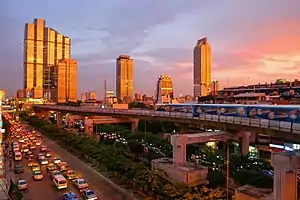Urban ecosystem
In ecology, urban ecosystems are considered a ecosystem functional group within the intensive land-use biome. They are structurally complex ecosystems with highly heterogeneous and dynamic spatial structure that is created and maintained by humans. They include cities, smaller settlements and industrial areas, that are made up of diverse patch types (e.g. buildings, paved surfaces, transport infrastructure, parks and gardens, refuse areas). Urban ecosystems rely on large subsidies of imported water, nutrients, food and other resources. Compared to other natural and artificial ecosystems human population density is high, and their interaction with the different patch types produces emergent properties and complex feedbacks among ecosystem components.[1]
In socioecology, urban areas are considered part of a broader social-ecological system in which urban landscapes and urban human communities interact with other landscape elements.[2] Urbanization has large impacts on human and environmental health, and the study of urban ecosystems has led to proposals for sustainable urban designs and approaches to development of city fringe areas that can help reduce negative impact on surrounding environments and promote human well-being.[3]
Bibliography
- Gibson, R.B., Alexander, D.H.M., & Tomalty, R. (1997). "Putting cities in their place: Ecosystem-based planning for Canadian urban regions". In M. Roseland (ed.). Eco-city dimensions: Healthy communities, healthy planet. Gabriola Island, B.C.: New Society. pp. 25–39. hdl:10613/2758. ISBN 9780865713536.CS1 maint: multiple names: authors list (link)
- Manfredi Nicoletti, L'Ecosistema Urbano (The Urban Ecosystem), Dedalo Bari 1978
References
- Keith, DA; Corlett, RT (2020). "T7.4 Urban and industrial ecosystems". In Keith, D.A.; Ferrer-Paris, J.R.; Nicholson, E.; Kingsford, R.T. (eds.). The IUCN Global Ecosystem Typology 2.0: Descriptive profiles for biomes and ecosystem functional groups. Gland, Switzerland: IUCN. doi:10.2305/IUCN.CH.2020.13.en. ISBN 978-2-8317-2077-7.
- Meirong, Su (2010). "Urban ecosystem health assessment:A review". The Science of the Total Environment. 408 (12): 2425–2434. Bibcode:2010ScTEn.408.2425S. doi:10.1016/j.scitotenv.2010.03.009. PMID 20346483.
- Steenberg (2015). "Neighborhood- scale urban forest ecosystem classification". Journal of Environmental Management. 163: 134–145. doi:10.1016/j.jenvman.2015.08.008. PMID 26311086.
